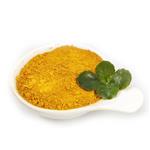
Acid Folic
- Product NameAcid Folic
- CAS59-30-3
- MFC19H19N7O6
- MW441.4
- EINECS200-419-0
- MOL File59-30-3.mol
Chemical Properties
| Melting point | 250 °C |
| alpha | 20 º (c=1, 0.1N NaOH) |
| Boiling point | 552.35°C (rough estimate) |
| Density | 1.4704 (rough estimate) |
| bulk density | 110kg/m3 |
| refractive index | 1.6800 (estimate) |
| storage temp. | 2-8°C |
| solubility | boiling water: soluble1% |
| form | Crystalline Powder |
| pka | pKa 2.5 (Uncertain) |
| color | Yellow to orange |
| Odor | Odorless |
| PH Range | 4 |
| PH | 4.0-4.8 (25°C, 100g/L in H2O) |
| biological source | synthetic (organic) |
| Water Solubility | 1.6 mg/L (25 ºC) |
| Merck | 14,4221 |
| BRN | 100781 |
Safety Information
| Risk Statements | 33-62-68 |
| Safety Statements | 24/25 |
| WGK Germany | 1 |
| RTECS | LP5425000 |
| F | 8 |
| TSCA | Yes |
| HS Code | 29362900 |
| Hazardous Substances Data | 59-30-3(Hazardous Substances Data) |
| Toxicity | A water soluble vitamin required in the diet of mammals. Sulfonamide drugs are selectively toxic to bacteria because they inhibit the incorporation of p-aminobenzoic acid into folic acid, a biosynthetic process in bacteria. Folic acid deficiency adversely affects prenatal development in humans. Dietary supplementation with folic acid dramatically reduces the incidence of neural tube defects in humans. Folic acid deficiency may also contribute to the causes of megaloblastic macrocytic anemia and a consequence of this is that this disease can be induced, as a side effect, when methotrexate, a folic acid antagonist, is used in cancer chemotherapy |

